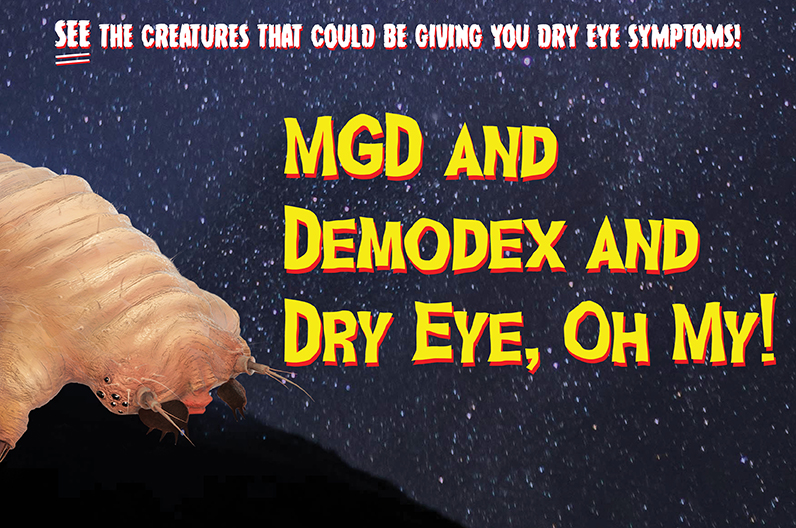(I-MED Pharma)
Meibomian Gland Dysfunction (MGD) is a major factor in Dry Eye Disease (DED), with upwards of 86% of DED sufferers showing evidence of MGD.[1] This chronic condition of the meibomian glands occurs due to duct obstruction and/or when there is a lack in the quality or quantity of meibum – the lipid component of the tear film – produced.[2] This alters the composition of the tear film which irritates the eye, and often results in the patient experiencing signs and symptoms association with DED. A variety of factors can affect the development of MGD including age, ethnicity, certain medications, contact lens wear, and many more.
 To enhance a tear film that may be lacking due to MGD, daily use of a preservative-free artificial tear is essential. I-MED Pharma’s I-DROP® MGD is the only premium viscoadaptive artificial tear targeted specifically for MGD. Containing both a superior quality hyaluronic acid as well as a lipid component to supplement the natural tear film, I-DROP® MGD is a preservative-free eye drop that provides superb coating and hydration to the ocular surface.
To enhance a tear film that may be lacking due to MGD, daily use of a preservative-free artificial tear is essential. I-MED Pharma’s I-DROP® MGD is the only premium viscoadaptive artificial tear targeted specifically for MGD. Containing both a superior quality hyaluronic acid as well as a lipid component to supplement the natural tear film, I-DROP® MGD is a preservative-free eye drop that provides superb coating and hydration to the ocular surface.

While there are many risk factors that can contribute to the development of MGD, Demodex is one that may require an in-clinic treatment by an eye care professional if it gets out of control. Signs and symptoms of Demodex include itching, burning, irritation, blurriness and swollen inflamed eyelids among many others that can lead to MGD. But first, what is Demodex and how is it associated with MGD?
Demodex are the eight-legged mites that live in the eyelids and eyelash follicles. All normal, healthy eyes have some Demodex colonizing the lids and lashes, but these mites can quickly become a problem if their numbers increase to the point of infestation. In addition to causing ocular issues including meibomian gland blockages, which alters the tear film, these mites introduce bacteria which leads to ocular inflammation. Demodex are also associated with various other skin and eye conditions such as rosacea and blepharitis. Tea tree oil in the correct concentration is found to be very effective in preventing the reproduction of Demodex found on eyelids and eyelashes. If a Demodex infestation is diagnosed, eye care professionals can guide the patient towards the correct treatment.
 I-MED Pharma’s I-LID ’N LASH® PLUS is a water-based hyaluronic acid cleanser that contains 5% tea tree oil, a compound that has antibacterial, antifungal, and anti-inflammatory properties. Used daily, it will help interfere with the reproduction of Demodex and help manage an infestation. A daily ocular hygiene routine that includes I-LID ’N LASH® PLUS is an easy way to remove ocular debris with minimal irritation as well as enhance the effectives of artificial tears such as I-DROP® MGD.
I-MED Pharma’s I-LID ’N LASH® PLUS is a water-based hyaluronic acid cleanser that contains 5% tea tree oil, a compound that has antibacterial, antifungal, and anti-inflammatory properties. Used daily, it will help interfere with the reproduction of Demodex and help manage an infestation. A daily ocular hygiene routine that includes I-LID ’N LASH® PLUS is an easy way to remove ocular debris with minimal irritation as well as enhance the effectives of artificial tears such as I-DROP® MGD.
For a complete ocular hygiene routine, I-MED Pharma’s I-LID ’N LASH® HOCL CLEANSING SPRAY can be used daily and in combination with I-LID ’N LASH® wipes or pump to maintain optimal lid and lash health. This all natural, non-toxic spray-and-go product contains .02% HOCl to clean and hydrate the lids and lashes and is formulated at optimal pH for ideal product stability. After cleansing and hydrating the lids and lashes, follow-up with one of I-MED Pharma’s preservative-free, viscoadaptive artificial tears for long-lasting comfort and relief from dry eye symptoms.
For any management plan to work effectively, daily treatment compliance is the key to experiencing long-lasting comfort and relief from discomforting ocular symptoms. With the right management tools, patients can experience everyday relief from MGD, Demodex, and DED.

[1] Lemp, M. , Crews, L. , Bron, A. , Foulks, G. & Sullivan, B. (2012). “Distribution of Aqueous-Deficient and Evaporative Dry Eye in a Clinic-Based Patient Cohort.” Cornea 31 (5): 472-478. doi: 10.1097/ICO.0b013e318225415a.
[2] Nelson, J Daniel, Jun Shimazaki, Jose M Benitez-del-Castillo, Jennifer P Craig, James P McCulley, Seika Den, and Gary N Foulks. 2011. “The International Workshop on Meibomian Gland Dysfunction: Report of the Definition and Classification Subcommittee.” Investigative Ophthalmology & Visual Science 52 (4): 1930–37. https://doi.org/10.1167/iovs.10-6997b.


 To enhance a tear film that may be lacking due to MGD, daily use of a preservative-free artificial tear is essential. I-MED Pharma’s
To enhance a tear film that may be lacking due to MGD, daily use of a preservative-free artificial tear is essential. I-MED Pharma’s 
 I-MED Pharma’s
I-MED Pharma’s 